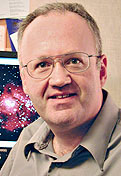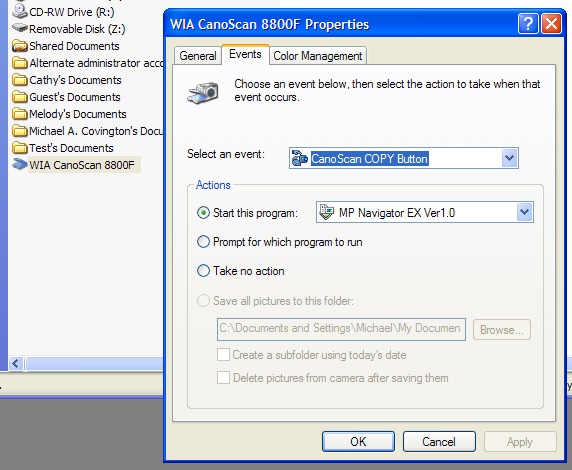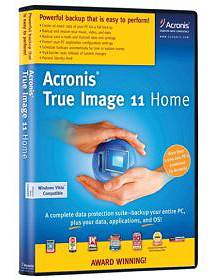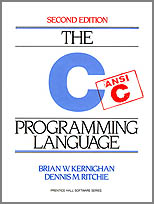|
2008 July 28-31 |
Must we all buy code-signing certificates? If you download software from the Internet, you've surely seen messages like this one by now:
Such a message can frighten a client who is security-conscious but not a software expert. The computer says not to trust the software! Windows (XP SP2 and up) produces this message when you run software that has been downloaded from the Internet and the software isn't digitally signed with a certificate from a certification authority. What do we mean by digitally signed? It has to do with public-key cryptography, which is a way of encoding messages so that you use one key (password) for encoding and another key for decoding. You make your decoding key public — in fact you deposit it with a reliable third party, so people can check on it — and then you use your private key to encode some portion of everything you send out. If that material decodes successfully with your public key, it proves the message came from you. The purpose of digital signatures on software is to verify that what your customer received is what you sent out — that the software hasn't been altered since you put it on the Net. This could be vital if your download is going to be "mirrored" (made available from multiple sites). Digital signing proves that no matter what path it took, it reached your customer unaltered. I write software which I sell or give away free. I'd like to sign it all digitally so people can be sure it's authentic. The problem? Digital signature certification is expensive — about $500 a year! For this price you can sign as much as you want until the end of the year, and then you have to renew. It can't be too cheap, because the certification authority has to vouch for your identity. We can't just issue a certificate to everybody who buys Windows, because then all a digital signature will mean is, "this software came from somebody who has Windows," which we knew already. (In fact, technically you can issue yourself a digital signature — in fact, that's the first step in getting one. But until you register it, it will be recognized as self-issued and it won't do you much good, except for proving that you're the same guy who used it yesterday or last week — which, in some situations, is enough.) There has to be a way to get it down well below $500 or even $100 a year. I would suggest lengthening the period (like $500 for 10 years) and working through professional organizations that already know people's identity. For example, I'm a Senior Member of the IEEE. I get a good deal on life insurance from them. Maybe I could get a registered digital signature the same way. Or maybe we can re-architect the Internet to make it safer. Digital signatures aren't needed if you can be sure you know where the software came from. Or maybe the real problem is Windows' alarming message. Maybe it inspires needless distrust. And sometimes, as Jim Mischel pointed out, it's just a pest. Closing out the month Doug Downing is about to come for a visit, and we'll work on a new edition of the Dictionary of Computer and Internet Terms. So the Daily Notebook will be on hiatus until some time in the first week of August. There may, however, be revisions to things already posted here. In the meantime, here are a few things that have been in the inbox... North Carolina artist Ruth Whiting paints what look, from a distance, like plants — but they are actually plugs and cables. Hmmm... Art for geeks! Programming language to look at: F# (F-sharp). It works like C# and thinks like Lisp or rather ML. We may be returning to a world in which there is more than one programming language. Does anybody remember the 1980s? Then C++ came along and convinced everyone it was the Only Language They'd Ever Need. Then Java was the same thing. Then C# (which is in fact the language I use the most). But Perl and Python are going strong, and now we have F#. Variety is a good thing. The old town spring of our fair city (Athens, Ga.) has been found, under (guess where?) Spring Street. Pictures to come, in some subsequent entry. Spammer tragedy: I've recently mentioned two spammers who were sent to prison. A third one, Eddie Davidson, recently became a prison escapee, murderer, and suicide. There is surely more to this story than we've heard, but it serves to remind us that large-scale fraud is a serious crime and spammers are not necessarily just pests. |
|
|
2008 July 27 |
More about student loans Further to what I was saying about student loan debt, see this article and accompanying discussion in The Economist. A common theme in the comments is that we should be beefing up middle-school and high-school education rather than lending people more money for college, and that a two-year (associate's) degree is enough college to get a disadvantaged person over the hump. To beef up the public schools, we need to change the way they're funded. Why not issue school vouchers so that education is paid for by the government but run by educators and parents, with plenty of genuine choice available? Autism explained? Here is an interesting picture that connects the rising incidence of autism with the amount of television that small children watch. People ranted about possibly harmful effects of too much TV in the 1960s, but really, it wasn't until the 1980s that we had lots of programs that really held the attention of young children, and VCRs with which to deliver them nonstop. Autism, you will recall, is a mental disorder characterized by difficulty with human communication and a tendency to pay attention to intricate details and mechanisms. In very mild form, it may actually be a talent rather than a handicap; people with mild autism tend to be good mechanics and computer programmers, but bad cocktail-party hosts (a small loss!). More severely autistic people range from very awkward to severely disabled; some of them can't talk or carry out activities of daily living. (Autism is sometimes characterized as unawareness of the thoughts and feelings of others. But it is very different from psychopathy or personality disorders. A person with a personality disorder thinks you have no thoughts or feelings, so he hurts you without compunction. An autistic person is keenly aware that you have thoughts and feelings, and he realizes he can't tell what they are, so he goes to extra effort to treat you kindly.) The jury is still out on whether this latest study is correct. I think part of the rise in the incidence of autism is due to better diagnosis, and it can often be detected in early infancy, before the child has had time to watch much TV. But it certainly stands to reason that excessive TV could push a person over the line from slightly abnormal to handicapped, or from handicapped to disabled. TV certainly trains you to pay a lot of attention to the details on the screen and ignore human interaction. I suspect the trigger is not the presence of TV but rather the absence of human interaction as the parent uses the TV set as a baby-sitter. |
|
|
2008 July 26 |
How to change Word 2007's defaults The defaults for creating a blank document in Word 2007 are stored a bit differently than in earlier versions. They reside on Normal.dotm, not Normal.dot. Various people have published instructions for setting everything the way you want it, one item at a time, but here's my quick approach to doing the whole thing. This is important because Word 2007's default text format is especially peculiar-looking, with a relatively small sans-serif font (Calibri). Here's how to change the default. (1) Get everything the way you want it. That is, create a blank document with all the fonts, styles, page layout, etc., set to your taste. You might do this by opening an existing document and deleting the text, or even opening a Word 2003 or earlier .dot file. If there is text that you want in all your documents — such as headings — put it in. Page numbers that are set to start on the second page are a really good idea. (2) Hit "Save As..." and save your document in Templates as NewNormal.dotm (that is, as a macro-enabled template, .dotm, not a regular template, .dotx; this is important). (3) Exit Word.
(4) In the Run or Search box, type:
(5) Rename Normal.dotm to OldNormal.dotm (you can't do this while Word is running). (6) Then rename NewNormal.dotm to Normal.dotm. There. Now start Word and make sure it works as desired. |
|
|
2008 July 25 |
Happy anniversary, Melody! Today we've been married 26 years. |
|
|
2008 July 24 |
Student loans: ticket to the poorhouse? [Updated.] [And updated again.] I keep hearing alarming stories about people who have borrowed huge amounts of money for a college education that isn't going to give them enough earning power to pay it back. Since student loans can't be discharged by bankruptcy, these people are going to be burdened for life. And we're about to have a whole generation of them. I think people are making several kinds of mistakes:
I would like to see some changes in the way student loans are handled. First, make private student loans become dischargeable by bankruptcy, like normal debts, after 10 years have elapsed. Only federal (Stafford) loans and the like should be totally protected. Second, limit interest-rate increases (in fact, I'm in favor of statutory limits on interest rates on all types of loans). And, third, what I'm doing now — put out the word that going deeply into debt is unwise. I'm talking about excessive debt loads. Many people can benefit from some student loans. My daughters are going to have student loans. (The interest rates on Stafford loans are too good to pass up.) But your student loan debt should be like the cost of a car, not like the cost of a mansion. It should be something you can reasonably expect to pay back in five years, even if you're not a superstar. Choosing a college and a major: Being a seasoned college teacher, I have some advice about that, too. I want to strike a balance between the idealism of youth and the financial caution of old age.
One last thought. The quality of the undergraduate scheduling and advising system is one of the most important attributes of a college. Ask carefully: Are the required courses actually available when needed, without overcrowding? Do students get expert help deciding which courses to take? Who advises them — experienced faculty members, or just clerical workers who have memorized a course list? How many students actually get through the degree program in the normal number of years? And one more thought. This is no place for football fandom. At larger universities, intercollegiate football has remarkably little to do with student life. Don't choose your college just because you or your family are fans of its football team. |
|
|
2008 July 23 |
A Plan 9 Newbie's Guide A small part of the work I did earlier this summer for Coraid, Inc. has been made public. They use AT&T's Plan 9 Operating System, a simplified successor to UNIX. I wrote this "newbie's guide" to help people get oriented. I want to thank Erik Quanstrom, who circulated it in the Plan 9 community and got some experts to make improvements. Plan 9 is a small operating system. You can do all your work with it if you really want to, though I find it a bit austere for the purpose. On the other hand, for embedded systems, it's great. It's small, free, and totally open-source, which means you're allowed to know everything that goes on inside it. |
|
|
2008 July 22 |
A matter of detail... It's remarkable what an experienced computer programmer can still be ignorant of. That's why I still read introductory treatments of programming languages that I know; they may reveal that I knew something that wasn't so.
So, for instance, I've just learned that, in all the C-like languages, the condition
in the for statement, such as i < 3 in
is tested before every pass through the loop, including the first one.
It follows that
I had had it in my head that the condition was only tested on the second and subsequent iterations. Computer programs that rely on this distinction are very rare, but now that I've been set straight, I can make a few of my programs slightly simpler. Short notes Skin that laptop: The top of my new computer is no longer just a black plastic surface with TOSHIBA in large letters in the middle. Instead, it sports one of my astrophotos and my web address. I got the custom-made plastic "skin" from skinit.com, and they did a very careful job. Financial trivia of the day: Post-dating a check doesn't work. The bank can still pay it immediately — and will, unless specially notified. Internet trivia of the day: www.example.com (the address that is reserved for use as an example) is a real web site and even answers pings. |
|
|
2008 July 21 |
Yet another gadget — Canon SD750 We needed a pocket-size compact digital camera for traveling, carrying in the briefcase, etc., and today we found a good deal on a Canon SD750. As you can see, the macro mode is not bad.
Apart from that, I haven't tested it thoroughly; it's easy to use and has a big 3-inch screen, but there is noticeable barrel distortion when the lens is set to wide-angle. |
|
|
2008 July 20 |
CanoScan 8800F scans slides I've briefly tried out my new CanoScan 8800F flatbed scanner for scanning slides. I haven't run a strict comparison to the other slide digitization methods I've tested, but my immediate impression is that the CanoScan is distinctly better than the Epson flatbed scanner, but I'm not sure how it compares to the Nikon dedicated slide scanner. The CanoScan actually claims a higher resolution, though it apparently doesn't focus the way the Nikon does; instead it relies on great depth of field.
Here you see the North America Nebula — a 10-minute exposure on Ektachrome 200 pushed 1 stop, taken back in September 2005 with a Nikon 180-mm lens, and digitized just now with the CanoScan. This is just a small part of the slide. I think the CanoScan captured everything that is on the film. |
|
|
2008 July 19 |
Jupiter with the 5-inch Just to verify that the new laptop will interface with my modified ToUCam, I took this image of Jupiter and Ganymede on the evening of the 17th, using my 28-year-old (!) Celestron 5 telescope and a 3× Barlow lens. Stack of about 3000 exposures through unsteady air.
One quirk manifested itself. I do the video capturing with MaxIm DL, but in principle, any software that accesses DirectShow drivers will work exactly the same way, because the pop-up windows for camera settings belong to Philips' driver. And what I found was that there are two windows — known to MaxIm as Video Capture Filter and Video Capture Pin — and they both let you set the frame rate. Differently. The higher frame rate apparently wins out. |
|
|
2008 July 18 |
Free mathematics Mathematical and statistical software packages such as MATLAB, Mathematica, Maple, SAS, and SPSS are very cheap for professors and students but very expensive for commercial users. Fortunately, mathematicians tend to be the kind of people who like to create free software. So what's out there as freeware? There is, of course, R, a highly respected statistics package. For symbolic mathematics, I've been asking around. Wikipedia has a handy list of software packages. Particularly recommended are PARI/GP and Sage. No, I haven't tried them yet. [Addendum:] Neither PARI/GP nor Sage supports Windows well. The math package that actually seems to meet my needs is Maxima, derived from MIT's famous MACSYMA. It comes with three user interfaces, command-line, xMaxima, and wxMaxima; of these, xMaxima gives the best tutorial but wxMaxima is handier in other ways. It doesn't have everything, but because of its background, I think it will be reliable for the things that it does handle. Short notes Was Shakespeare Catholic? You heard it here first.. Another spammer is in the slammer. In my opinion, the Internet — or rather its users — need a lot more law enforcement. The Internet isn't a "hobby" any more than the telephone is a hobby. Some new Federal Reserve mortgage lending regulations are finally slated to take effect. Who would have thought that a bank would have to be told to check whether borrowers are going to be able to make their payments? Here (thanks to Pete Albrecht) is another site that tells you how financially secure your bank is. And here is a profession I didn't know about — daily money managers (DMMs). Who needs a DMM? Older people in poor health, and also people who travel a lot, sailors who are at sea for months at a time, and so forth. Sounds useful... Finally, read about some of New York City's gargoyles. One of the angels on Riverside Church apparently has the face of Einstein (who was middle-aged and at the height of his career when it was carved). |
|
|
2008 July 17 |
Floating-point: worse than you thought Every properly educated computer scientist knows that floating-point numbers have some unexpected properties. For example, on a computer that does arithmetic in binary (which is most of them), 0.1 + 0.1 + 0.1 + 0.1 + 0.1 does not exactly equal 0.5. Why? For the same reason that, in decimal, 0.333 + 0.333 + 0.333 does not equal 1 (even if you thought 0.333 was 1/3). The reason is that 1/3 would require an infinite number of decimal places. 0.333 is close, 0.3333 is closer... In the same, way, 0.1 (= 1/10) does not have an exact finite representation in binary. But a new paper by David Monniaux points out that the situation is even worse than that. There are computers (including Pentiums) on which a floating-point variable x might be less than 1.0 some of the time, and not the rest of the time, even though nothing (that you know of) has changed it. Why? Because the 8087 math coprocessor, and all its descendants, store floating-point numbers in 80-bit registers, but when a number is transferred to memory, it usually goes into a 64-bit quadword. Ditto the 68000 CPU. That means the value can change when a computed value is moved from a register to a variable in memory. (Imagine 0.99999 turning into 1.00000 when moved into a place without enough decimal places — except that in fact, we're dealing with binary.) And programmers generally have no control over whether this happens, although in Gnu C, the -ffloat-store option lets you demand that every value be stored in memory as soon as it's created. Wavelets If you don't understand wavelet theory, let me recommend The illustrated wavelet transform handbook, by Paul Addison. It starts at just the right level. Although it has to assume some acquaintance with calculus, all the concepts are fleshed out with real examples, and (unlike many of its competitors) the book is written in English, not in integrals. |
|
|
2008 July 16 |
Quote for the day On the foreclosure crisis, from Bankrate columnist Holden Lewis: I'm all for experimenting with short refis [partial debt forgiveness] for owner-occupants who are in genuine financial hardship. If I could give one piece of advice to the FDIC, it would be this: Before offering a workout to a delinquent borrower, insist on seeing the tax returns for the year the borrower got the loan, and the two years prior. If the borrower lied about his or her income on the loan application, proceed with foreclosure. [Addendum:] It's not quite that simple. Who did the lying? Did the bank fill out forms falsely and give them to the customer to sign, perhaps telling him the income figures had been adjusted in some way? But in any case it doesn't make sense to "help" people who could not have afforded the house with their actual income if the terms of the loan had been normal. Such a person isn't "losing" a house — he never had one. |
|
|
2008 July 15 |
Tool of the day: Ridgid SeeSnake Micro
Most impressive thing I've seen in a hardware store lately: the Ridgid SeeSnake Micro. It consists of a tiny video camera and light source on a flexible shaft, with a 2.5-inch full-color screen on the handgrip. You can use it to see what's inside pipes, walls, and machinery through just a small opening. The camera is less than 3/4 inch in diameter. It's under $200 at Amazon and Home Depot. I can't justify buying one right now, but in five years, no mechanic is going to want to do anything without a tool of this kind. And just think — if I'd thought of it, I could have built one. The components have been available for some time at a total cost not much different from what the unit sells for. I think I'll hold out for one with a bigger screen and maybe a USB video output. More about how to tame Adobe Acrobat Yesterday I told you how to disable the read-out-loud function of Acrobat so you don't get pop-up dialog boxes about it every time you open a document. It may be sufficient to make a much smaller change: go to Edit, Preferences, General, and uncheck "Make Hand tool read articles." More importantly, I want the Hand tool, rather than the selection cursor, to be in effect when Acrobat starts up, so I can use the arrow keys to move around the document more easily. To achieve this, go to Edit, Preferences, Accessibility, and uncheck "Always display the keyboard selection cursor." The people at Adobe seem to be so eager to accommodate the visually handicapped that they have set a lot of defaults wrong for those of us who are not visually handicapped. Is your bank broke? In the wake of the IndyMac bank failure, some journalists are trying to stir up panic, but the fact is that the FDIC did its job and you don't have anything to worry about unless you have more than $100,000 in one bank. I thought everybody knew $100,000 was the FDIC insurance limit. Other banks are also weak. To find out if yours is OK, check Bankrate's free rating system and look for at least 3 stars, or a numerical rating of 1, 2, or 3. |
|
|
2008 July 14 |
What did sans-serif type look like
I've been digging up the history, and what strikes me is that sans-serif type had very different connotations at different times. From the invention of printing through the 1800s, almost all type was of the "serif" variety, like the first example in the picture. Serif type originated in Roman inscriptions, and the serifs were probably originally guide marks for the stonecutters. There were no lowercase letters until the Middle Ages; early printed books took over lowercase letterforms from handwriting. The Romans did have a bit of sans-serif writing, and archeologists considered it more primitive than normal lettering. It was all uppercase, of course. Mixed upper-and-lowercase sans-serif lettering broke upon the world in 1748 in Stourhead Grotto, part of a collection of replicas of (real and imaginary) ancient buildings. Apparently the sculptor thought leaving off the serifs made the inscription look more ancient. In the early 1800s, some typefoundries started offering sans-serif type, which they called "Egyptian" and which was supposed to look extremely ancient, preclassical, and primitive, like something found in a pyramid. Many of these Egyptian fonts were all uppercase. Once people started seeing sans-serif type, it became popular for signs, posters, and labels because it was easy to draw or paint. So from the mid-1800s to the mid-1900s, sans-serif type was mainly for labels and (later on) especially for road signs. Most of the sans-serif fonts of the time were not very skilfully designed; they looked clunky. In Germany between the World Wars, sans-serif type also acquired a different connotation — it was a modern substitute for Fraktur (black-letter, "gothic"). In this connection, sans-serif began to stand for modern efficiency. I have seen Zeiss ads from the 1920s that look like they came out of the 1960s, with generous use of whitespace and sans-serif type. Melody tells me this kind of thing came out of the Bauhaus, cradle of modern architecture. But it didn't catch on. Meanwhile, starting in the 1920s, there was a change in how American schoolchildren learned to write — they no longer had to produce cursive in first grade. Instead they learned "manuscript," a simple kind of sans-serif hand-lettering, and then moved on to cursive a couple of years later. Thus, a form of sans-serif became part of everyone's education for the first time. Sans-serif type became a symbol of modernity again after the release of Helvetica in 1957, and this time it caught on worldwide. In the 1960s and 1970s, sans-serif type meant you were modern and fresh, that you had put aside the stodgy practices of the past. What snuck by me — since I'm older that many of you — is that today, sans-serif type is just neutral, with no particular connotations. It does not even connote modernity; it's just type. Newer, even better-balanced sans-serif fonts keep being designed (I particularly like Adobe Myriad). Their goal is to improve slightly on what we already had, rather than to give us something radically new. Melody, who is trained in typography, is fond of pointing out that type design is an art in which you can't be totally original because people have to be able to read what you've created. Incidentally — though this is material for another notebook entry — people who lived through the first half of the twentieth century also lived through a major change in serif typefaces. Those serifs don't fit on the ends of the letters the same way they did before 1931, when Stanley Morison came out with Times Roman. More about that another time. Astrophotography with a non-SLR digital camera Joe Sheppard is doing impressive things with a Sony Cybershot digital camera aimed into the eyepiece of an 8-inch Dobsonian telescope on an equatorial platform, using exposures of 30 seconds or less. Check out his results here. Stopping Adobe Acrobat "reading" pop-ups For more about how to tame Acrobat see July 15. Ever since update 8.1.2, Adobe Acrobat has been besieging me with pop-up dialogs about "reading" or "accessibility" every time I view a document. This is because it has the ability to read documents out loud with a speech synthesizer — a boon to the visually handicapped. But I don't need those features. There is no menu setting to turn them off. Instead, go to C:\Program Files\Adobe\Acrobat 8.0\Acrobat\Plug-ins, find accessibility.api and readoutloud.api, and rename them so their names don't end in .api. That will shut them up... ...until the next update restores them, and we have to do this again. |
|
|
2008 July 13 (Extra) |
Scanner buttons and If the buttons on your scanner bring up a message, "Select the program to launch for this action," or if they launch the wrong software, here's what to do. Go to My Computer, find the scanner, right-click on it, and choose Properties. Set each scanner event to launch the right software (for Canon, MP Navigator). Now you know.
|
|
|
2008 July 13 |
Good first impression: Acronis True Image 11.0 [Updated.]
About $40 buys you a one-machine license. The software comes on a bootable CD, so even if your system becomes unbootable, you can start Acronis from the CD and restore your disk. I, of course, installed the software under Windows in the normal manner and ran it. I opted for a "sector-by-sector" backup of all four hard disk partitions (Windows, Toshiba Restore, Linux, and Linux Swap). (You can equally well choose files and folders just as in NTBACKUP.) Projected to take 10 hours, the operation actually completed in two, including verifying the copy. About 80 GB of data compressed to 37 GB on my external Toshiba USB hard disk. Then I launched the restore utility, just to see if it would work. I figured that since I had backed up "sector-by-sector," I'd only be able to restore entire partitions. Pleasant surprise #1: It recognizes Linux as well as Windows filesystems. Pleasant surprise #2: Even when you back up whole partitions sector-by-sector, you can restore file-by-file. Pleasant surprise #3: Even across operating systems (Linux to Vista, Vista to Linux)! I noticed one quirky thing about the 37-GB backup file that I created. Windows showed its length as 0 until creation was actually complete. Acronis must have been doing something low-level, sector-by-sector, when writing it on the disk, rather than going through the Windows file system. That may explain why the backup finished so quickly. Before giving Acronis True Image my seal of approval I tried actually restoring some files, just to prove that it works. (Backups are no good unless you're sure you can restore from them.) And indeed it worked — I was even able to restore a couple of Linux files onto my Windows desktop. There's just one disadvantage — they don't offer a multi-CPU license. It's about $40 per computer, no matter how many computers you have. I want to thank whoever recommended Acronis to me, and now I can't track down who it was. Jeff? Jim? Miscellany Telemarketer gets arrested, abandons BMW in front of Pete Albrecht's house — Read it and be amazed. And now Pete tells me they're calling him again, still wanting to come and clean his carpets.
I would have appreciated more solid information about how Helvetica came to be designed, and in particular, the world into which it came. Before 1957, there wasn't much sans-serif type to be seen, except for road signs and labels on machinery, and they weren't elegant. The British had Gill Sans, mainly for signage, and the Germans had been using Akzidenz Grotesk occasionally for a long time (e.g., there are Zeiss ads from the 1920s in a close precursor of Helvetica). Then Helvetica came along, and I can remember when it was synonymous with modernity. Helvetica type meant that a company or organization was modern and streamlined. From connoting modernity, Helvetica has become, as far as I can tell, the current era's perfectly neutral typeface, with no strong connotations at all. Microsoft isn't the only software enterprise with public image problems. One prominent Linux programmer, the author of a widely used filesystem, is now a convicted murderer. Really bad idea that sounded good at the time: AVG Antivirus tries to pre-scan all the links in the web page you're viewing. That is, in the background, it "clicks on" them and downloads their content to scan it. The problem? It causes a lot of unwanted Web traffic — tremendously more than normal browsing would cause — and it makes it look as if you've clicked everything, even such things as the FBI's decoy porn sites. |
|
|
2008 July 12 |
Sick day About five days ago I had some minor flu-like symptoms... but kept working. During the week I felt slightly below par and "off my game" — so I ended up doing lots of computer maintenance and not a lot of real research. Finally, this morning (July 11) I woke up with a badly upset digestive system, which gradually got better, and a sore throat, which is still bothering me. Accordingly, I'm not going to have a very active weekend. Clients: I hope to catch up with everything next week. If I don't, you won't be billed for it. Obligatory pun: I didn't work much, nor eat much. So it was both a slow day and a fast day. :) |
|
|
2008 July 11 |
How to make a 'Send Mail' icon in your Start Menu In Windows, it would be handy to have an icon which would launch your default mail client — whatever it might be — in send mode, ready for you to type the address and the message. The following instructions tell you how to do this. They are exact for Vista and probably work with no modification under Windows 2000 and XP. (1) On the desktop, right-click and choose New, Shortcut. For the location, instead of a filename, type: cmd.exe /c start mailto: For the name, type Send Mail. You may also want to change the shortcut's icon and set it to run minimized. You can do that by right-clicking on it and choosing Properties, now or later. (If you try to change the icon, you'll find that cmd.exe doesn't contain any other icons. Click "Browse" and choose shell32.dll, which contains plenty of them.) (2) If all you want is an icon on your desktop, you're done. To get it into the Start Menu, proceed as follows... (3) Right-click on the Start button and choose "Open All Users." Move or copy your new shortcut into the Programs folder within the start menu. (4) Right-click on it and choose "Pin to Start Menu" so it's always visible. People keep each other quiet in the library Today's observation about human nature: A library that is 20% full (of people at desks) is quieter than an empty one. When a library is almost totally empty — as the University libraries were on Monday — there will be one or two people talking loudly, laughing, guffawing, or emitting miscellaneous sound effects that disturb the peace of the entire place. When there are 20 or 30 people in a big room, they will whisper quietly to each other, but they won't make loud noises. |
|
|
2008 July 10 |
Querying the CPU speed in C# Windows has an elaborate system called WMI (Windows Management Interface) that enables programs to retrieve information about the computer. Here is some code that retrieves the current (actual, even if variable) CPU speed in gigahertz, or returns null if it's not available (e.g., because of lack of security privileges).
using System.Management; This is slightly unusual code. The only way to get into a ManagementClass object collection is to use the enumerator — subscripts won't do — so for brevity I used foreach, followed by an immediate obligatory break. The other unusual thing is that if an exception is caught, nothing happens — doing nothing is precisely the desired action. Finally, for those who haven't seen it, double? (with the question mark) means "double-precision number or null." Incidentally, while Googling "ManagementClass" I seem to have found every "anger management class" in the world! |
|
|
2008 July 9 |
Short notes After several weeks of reporting that the value of my house is rising sharply, Zillow is today refusing to give any estimate of its value. Maybe they figured out something was wrong with their calculations. Disconcerting high-tech prank: A slave-flash-projector or "image fulgurator." Disguised as a camera, it is actually a slave flash that goes off when somebody else's flash fires, and instead of just lighting up the surroundings, it projects an image. This gives you a way to insert graffiti into other people's snapshots without their knowing, at the time, where it came from. Clever, but disconcertingly amoral. Related, however, to successful devices for foiling paparazzi, such as mounting slave flashes on your hat to shine back at them. And here's an interesting item on the origin of one of my favorite prayers. Deus, cui omne cor patet... |
|
|
2008 July 8 |
C is not quite as bad as I said
Not only that, they had an odd kind of snobbery or machismo that worked against good practices. Well-written computer programs look simple and clear. But if you want your colleagues to think you're a more "advanced" programmer than they are, being simple and clear is not your goal. There was also widespread folklore that strange techniques were necessary "for speed." Thus the excessive use of pointers and the disdain for bounds-checking. But the best thing ever written in C — the UNIX operating system — has none of these characteristics. At least, Kernighan and Ritchie's published examples (which I've been reading) don't. They're nice and clear and simple, and therefore reliable. We have to remember that C was a replacement for Fortran, not Pascal or Java. Many things were later done in C that should have been done in a more advanced language. C++ tried to be the more advanced language, but I think it became too popular for its own good; it was meant to be a temporary prototype; Java and C# are the real thing. Linux users who do not have the standard Windows or Macintosh font set may (I hope) notice that this page looks better than it did. I'm going to continue to make improvements to the font specifications. |
|
|
2008 July 7 |
Rulon S. Wells III, 1918-2008 I note with sadness the passing of my Yale major professor, Rulon S. Wells III, at the ripe old age of 90. If that name sounds familiar to you, and you are a Westerner or a Mormon but not a linguist, then you may be thinking of his grandfather, a prominent Utah politician and Mormon churchman. Professor Wells had the good fortune to do some really important work early in his career. As a result, when my fellow students and I met him in the early 1980s, knowing that his best work was 35 years in the past, we expected someone considerably older than he turned out to be. To some extent, he played this role by dressing very conservatively, so that he looked as if he had walked in from the Yale of the 1940s. Rulon Wells was the Linguistics Department's polymath. His specialty was unusual topics; for instance, he taught courses on diachronic semantics back when nobody knew there was any such thing. Indeed, the unifying characteristic of his seminal papers back in the 1940s was that he looked at standard methods of linguistic analysis from outside the paradigm, and as a result, was able to see how they really worked. His work had a mathematical flavor, though the relevant branches of mathematics did not yet exist. Like me, he preferred to break new ground on completely novel problems rather than to continue mining what other people had already discovered. The main thing I learned from him was to put a high value on mental adaptability — to consider any theory sympathetically and try to understand and classify it, no matter how strange it seems, and no matter whether it's going to turn out to be completely false. I also remember with amusement this remark: "Semantics is a labyrinth. But here is a cheering thought. Our goal is not just to get out of the maze, but also to explore it." Revisions Yesterday's long entry has been revised and is now even longer. |
|
|
2008 July 6 |
The Ubuntu experience (Updated.)
(At least it sounds African. The entrepreneur behind it is from South Africa but operates internationally; there's a bit of African music in Ubuntu's startup sequence; at least Ubuntu makes a nod toward African culture. The software of course is assembled mostly from Linux distributions that come from Europe and North America.) I set apart 10 GB of my new laptop for an alternative OS and have installed Ubuntu. Initial impressions:
And in case anyone is reading this who hasn't already heard, Ubuntu Linux is FREE. You can download it or pay a few dollars for a disk (as I did), but then there's no limit to how many copies you install, and no online activation. You can pay for support — that's how they make their money — but you can still install any number of copies free if you aren't going to use the support service. Some government agencies have adopted Linux for office work. The potential cost saving is enormous — several hundred dollars per PC — and the free software includes not only web browsing and e-mail, but also OpenOffice.org, a quite decent word processor, spreadsheet, etc. And Linux is unusually virus-resistant and normally does not need antivirus software. This is partly because Linux decided to forego some of the excessive versatility that makes Windows vulnerable; partly because Linux users are more sophisticated and more likely to notice abnormal activity; and partly because it's a smaller target — there are fewer Linux machines, meaning fewer virus authors want to target Linux, and if a Linux virus is released, it probably can't find more Linux machines onto which to spread. My use for Linux is different: running UNIX scientific software, maybe developing software for UNIX embedded systems, and maybe surfing the Web in places where I'm really afraid of viruses. How does Linux do it? As I see it, their secrets are:
Of course, if you run UNIX scientific software, Linux is ideal, and Ubuntu is an uncommonly easy-to-install distribution of it. Looking very good: Canon CanoScan 8800F
The first time through, in order to get the buttons to work, I had to tell Windows (in response to a prompt) that they should activate MP Navigator, which is Canon's image-management program, and then I had to set some parameters. (For instance, I like for scanned image files to go onto my desktop rather than into My Documents.) Once this is set up, working with this scanner is remarkably quick. Until the buttons forget that they're supposed to activate MP Navigator! Solution here. The ability to make copies with the speed of a Xerox machine, laser-printed on my HP printer, makes this scanner a real time-saver. I've done a lot of copying with it already. I haven't used it to scan film yet. It claims to have more resolution (optically) than most dedicated film scanners. My Epson flatbed scanner was perceptibly inferior to a Nikon film scanner, but the Canon 8800F has had four more years for the technology to mature. I'll test it soon. |
|
|
2008 July 5 (Extra) |
Some changes in the programming culture of Windows I've been reading Kernighan and Pike, The UNIX Programming Environment, and E. S. Raymond, The Art of UNIX Programming — not because I want to do a lot of UNIX programming, but because these books tell us how some great software tools came into existence. The creators of UNIX were acutely aware that programming is a human, cultural activity. They wrote tools for their peers, rather than for their subordinates or for ill-defined "end-users." Further, UNIX was the first OS whose purpose was really to let programmers do what they want rather than impede them. Earlier operating systems had, as one of their major goals, preventing the user from using too many CPU cycles. Programs were expected to be large and surrounded by elaborate preparations. UNIX was designed for easy development of small programs, whether for experimentation or for repeated productive use. Microsoft Windows programming culture, ten years ago, wasn't very promising. Apart from Delphi, which didn't come from Microsoft at all, there was little or nothing on Windows that clearly surpassed rival operating systems. There was a vocal community, mostly clamoring for better tools rather than rejoicing in what they had. We used Windows because it was what all the end-users had. In the past few years, though, Microsoft has made some shifts in the Windows programming culture. The biggest is the .NET Framework, which finally provides a good, Delphi-like API for the whole operating system. Like UNIX (but in different, newer territory), .NET takes a lot of tasks that used to be hard and makes them easy. If you're a programmer, the operating system supports you instead of restricting you. Essentially, within Windows there is a separate, different OS struggling to get out, and .NET is it. But there have also been other shifts:
The effect is to narrow the gap between the professional (commercial) and the amateur (experimental) programmer — in fact, one could argue that Visual Studio, with its $100 academic price and the free "explorer" versions, eliminates the gap. And that's a good thing. It tells us Microsoft has finally realized that what's good for programmers is good for everybody. |
|
|
2008 July 5 |
Cleaning out the inbox As I've said before, this Notebook is not a "web log" of everything I do. It's more like a daily newspaper column. In fact, one of its literary precursors is the newspaper column series written in the 1960s by Hal Boyle, a writer who deserves to be better remembered (he's not even in Wikipedia). His columns were almost the only thing in the newspaper that I read regularly as a child. Some of Boyle's columns would start out, "Things a columnist wouldn't know unless he opened his mail," and that's the inspiration for my "Cleaning out the inbox" entries, of which today's is one. Here are short notes on things that have caught my attention lately. Today I went ahead and released an unfinished web page about how to adjust a Stereozoom 4 microscope, drafted last summer and never finished. I'm thinking of setting up this laptop to dual-boot and was delighted to discover that you can shrink a disk partition in Windows Vista. That is, you can take disk space away from Vista without reformatting, to make a Linux partition. The Ubuntu Linux people are on top of this and have worked out all the details. (If Vista says no "shrink space" is available, you have a system file at the high end of the existing partition and will have to move it; click here.) Hot new cameras: Not only the Canon EOS XSi (450D), but also the new Canon EOS XS (1000D), looks very promising for astrophotography, with live focusing. The price-performance ratio gets better every month. The street price for this one may be as low as $600, body only. Product to avoid? Opteka RL-500 ring flash, according to the customer reviews on Amazon. Should cars have "black boxes"? Some insurance companies are experimenting with electronically monitoring your driving habits and giving you a discount if you're a safe driver. (They can tell whether you're a tailgater by your acceleration and braking pattern.) Some people might scream, "Invasion of privacy," but I feel that the public roads are not a private place. When you drive in public, you're taking my life into your hands, not just your own. I can understand that tracking where you drive is a matter of privacy, but the physical parameters of the vehicle? Not private at all, especially if you're paying someone else to insure it. And of course a "black box" to record the details of a crash could be very valuable. Yes, this means they'll know if you were speeding or driving recklessly. Economic bombshell: There's a possibility of mass cancellation of mortgage loans (at the borrower's request) if banks are found to have violated truth-in-lending laws. The courts haven't finished ruling on this. By "cancellation" they apparently mean "rescission," i.e., reverting to the way things were before the loan was made. (You get all your payments and interest back, but also all your original debt.) That could get clumsy, but it seems to mean you've had the house rent-free while the "illegal" loan was going on. Then, if you can afford it, you can get a new loan at today's fixed rates. The real problem with the mortgage crisis is that everybody passed responsibility to someone else — brokers to lenders, lenders to investors — so nobody was afraid of lending money they wouldn't get back. Perhaps this was the culmination of the "other people's money" catchphrase that had been circulating in business schools for a couple of decades. |
|
|
2008 July 4 |
Moving day Moving into a new computer takes a ridiculously long time — not that I have any time to spare, but I'm doing it anyway. Melody and I have new Toshiba A205-S5843 laptops (this week's bargain at Office Depot). The University provides me a laptop to use for research, but an increasing number of things need to be done on non-University equipment (for reasons of intellectual property claims, not just ethics), so I decided I needed my own. And Melody had been overdue for a new laptop for quite a while. This particular Toshiba struck me as solidly built and well ventilated (on the side, so it doesn't heat up your lap). Because we have two just alike, we gain some reliability — we can swap parts if necessary. I took the opportunity to update a good bit of my software. Office 2007 has been redecorated in an way that I think I like, especially the "full screen" mode in Word, with just a minimal menu at the top. Photoshop CS3 opens Canon raw files, which is handy. Beyond that, I haven't dug very far. Anyhow, now you know one more thing that's keeping me busy! Why your PC crashes (and it isn't Vista's fault) [Updated.] Today at lunch, one of my expert colleagues pointed out why PCs crash unpredictably: Except for server-class machines, they use non-ECC RAM and cannot recover from memory corruption caused by cosmic rays or environmental radioactivity. Many use non-parity RAM and cannot even detect that anything has happened. That is, a cosmic ray or other subatomic particle comes along and flips a bit in memory. We observe this on CCD images; it also happens to memory chips. And when it does, if the chip isn't designed to recover (or at least report the problem intelligently), you get a mysterious crash. And, of course, you blame Windows Vista. |
|
|
2008 July 2-3 |
The star clouds of Scorpius Here are a couple of Canon EOS 20Da pictures I've just gotten through processing. Each was a stack of several 4-minute exposures at ISO 800 using a Sigma 105/2.8 lens at f/3.5, from a dark site. First, the field of Antares and Rho Ophiuchi. Here you see stars, a globular star cluster (at lower right), reflection nebulosity (blue-gray), emission nebulosity (reddish), and dark nebulosity (in long streaks, in front of everything else). It's a spectacular scene, but hard to photograph. 
Second, the little-known emission nebula IC 4628 in southern Scorpius, along with star clusters, star clouds (toward the bottom), and various kinds of nebulosity: 
Both were taken at Deerlick. Busier than usual I'm quite busy at the moment and am not responding to all e-mails immediately. Please don't panic if it takes two or three days for me to answer a message, especially one requiring thought or work. Thanks. |
|
|
2008 July 1 |
A new job?
Firefoxed Those of you who use Firefox may have noticed that my highly-touted move toward the center didn't work. Well, now it does. I start the body of the page, not with <body style="text-align:center"><div style="width:900px;text-align:left"> but rather with <body><center><div style="width:900px;text-align:left"> and of course end it with: </div></center></body> I have also adjusted some type size specifications so that the view in Firefox will be more nearly the same as in Internet Explorer 7. Lack of traffic One backhanded advantage of $4 gasoline is that it has apparently made our highways a lot safer, or at least less crowded. Over the weekend we took a road trip. Driving on I-16 and U.S. 441, at night, I actually got to use the high beams because there often wasn't another car in sight. That's an experience I don't remember having since the 1970s. |
|
Entries are most often uploaded around 0000 UT on the date given, which is the previous evening in the United States. When I'm busy, entries are generally shorter and are uploaded as much as a whole day in advance. |












 Today, all of us are accustomed to seeing a lot of
sans-serif type, like the second example in the picture.
Younger people may find it hard to believe that
this kind of type was seldom seen before the 1960s,
except on road signs. The first really popular sans-serif
typeface, Helvetica, dates only from 1957.
Today, all of us are accustomed to seeing a lot of
sans-serif type, like the second example in the picture.
Younger people may find it hard to believe that
this kind of type was seldom seen before the 1960s,
except on road signs. The first really popular sans-serif
typeface, Helvetica, dates only from 1957.






